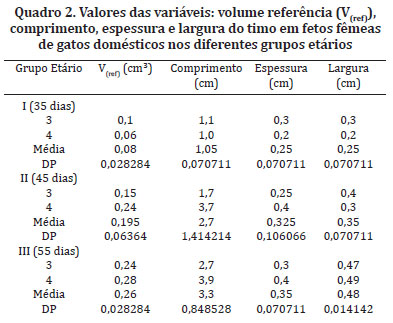The thymus is a primary lymphatic organ that develops its activity in young organisms. But despite its function is fundamental mechanisms responsible for the acquisition and subsequent body defenses, it is not yet fully understood, neither the morphological basis accounting for such functions as the process of development and the organ involution. The objective was to analyze and characterize the morphology of the thymus, such as its size and volume, and histological aspects of the thymus in cats, correlating sex and age development. Twelve foetus of mongrel domestic cats (Felis domesticus), males and females, divided into three age groups. The thymus presented two parts with a pale pink color, the thoracic and cervical portion; each has a right lobe and a left lobe mostly. The thoracic portion was located in the region of cranial mediastinum, between the lungs and the heart base. And the cervical portion extended beyond the ribs cranially and is located ventral to the trachea. The thymus cellular structure was shown by the presence of organized concentric aggregates, named Hassall's corpuscles, formed by epithelial cells, supported by a connective tissue capsule that penetrated the parenchyma dividing it into lobules. Significant changes with number of lobes and thymus size between individuals of the same age, and between sex. The values for length, thickness and width, in general, showed an increase, according to the development of animals, with differences between sex.
Thymus; morphometry; linfoid organ; T lymphocyte; Felis domesticus cats



